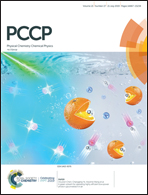Unveiling the electronic structures and ligation effect of the superatom–polymeric zirconium oxide clusters: a computational study
Abstract
Discovering the non-noble ZrO cluster as an analog of the noble metal catalyst Pd is of significance toward designing functional materials with fine-tuned properties using the superatom concept. The effect of gradually assembling the ZrO superatomic unit on the electronic structures and chemical bonding of larger ZrO–polymeric clusters, however, is unclear. Herein, by using density functional theory (DFT) calculations, the lowest-energy structures and low-lying isomers of the (ZrO)n−/0 (n = 2–5) clusters were optimized, in which every O atom in these clusters tends to connect its adjacent two Zr atoms forming metal oxygen bridge bonds. Insights into the electronic characteristics of these clusters were obtained by analyzing their molecular orbitals (MOs) and density of states (DOS). More importantly, our studies on the CO (electron acceptor) and PH3 (electron donor) ligated Zr3O3 clusters unveil that the ligation process can substantially alter the electronic properties of the clusters by tuning the HOMO and LUMO states, which may have potential applications in photovoltaics. Strikingly, the successive attachment of PH3 on Zr3O3 dramatically lowers the adiabatic ionization potential (AIP) of the ligated clusters, resulting in the formation of stable superalkali clusters with large HOMO–LUMO gaps. Furthermore, the potential of constructing the superalkali Zr3O3(PH3)5 based 1-D cluster assembled material was also examined.



 Please wait while we load your content...
Please wait while we load your content...